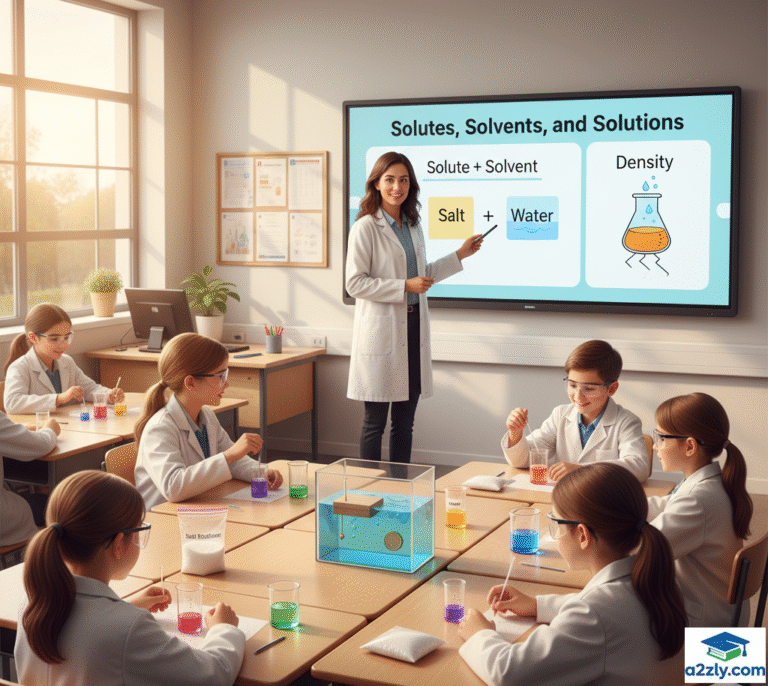🧭 Chapter Overview
Every sip of lemonade you enjoy, every ORS you drink when you’re sick, and every breath you take — all involve solutions. From the oceans that sustain life to the blood in our veins, nature thrives on the art of mixing.
This chapter, “The Amazing World of Solutes, Solvents, and Solutions”, explores how substances mix, why some dissolve while others don’t, what makes water the “universal solvent,” and how scientists measure density — the property that explains why ice floats while iron sinks.
By the end of this lesson, you’ll understand not just the how, but the why behind one of chemistry’s most fascinating topics.
Table of Contents
🎯 Learning Objectives (NEP 2025 Competency Table)
| Competency | Learning Outcome | NEP Skill |
|---|---|---|
| Conceptual Understanding | Define solute, solvent, and solution | Conceptual Clarity |
| Analytical Thinking | Differentiate between types of mixtures | Logical Reasoning |
| Application | Perform experiments on solubility and density | Practical Competence |
| Critical Thinking | Explain floating/sinking using density | Problem-Solving |
| Cultural Awareness | Explore India’s heritage in salt-making and solutions | Values Integration |
🧂 9.1 What Are Solute, Solvent, and Solution?
Take a glass of water and add sugar. Stir. The sugar disappears — yet the water tastes sweet.
That’s because a solution is formed: a uniform mixture where the components can’t be seen separately.
Definitions:
- Solute: The substance that gets dissolved (e.g., sugar or salt).
- Solvent: The substance that dissolves the solute (e.g., water).
- Solution: The homogeneous mixture formed after dissolving.
Equation:
Solute + Solvent → Solution
| Type of Solution | Solute | Solvent | Example |
|---|---|---|---|
| Solid in Liquid | Salt | Water | Salt solution |
| Gas in Liquid | CO₂ | Water | Aerated drink |
| Liquid in Liquid | Alcohol | Water | Spirit solution |
| Gas in Gas | Oxygen | Nitrogen | Air |
Did You Know?
Air is a gaseous solution, where nitrogen acts as the solvent, and oxygen, carbon dioxide, and argon act as solutes.
🍯 Real-Life Example:
The chashni (sugar syrup) in Gulab Jamun is a real-world example — water acts as the solvent even though sugar is present in a larger amount!
🧪 9.2 How Much Solute Can Be Dissolved?
Every solvent has a limit — a point where it cannot dissolve more solute.
Activity Insight:
Add spoonfuls of salt to water until it stops dissolving. That’s when you get a saturated solution.
| Type | Description | Example |
|---|---|---|
| Unsaturated Solution | More solute can be added | One spoon salt in water |
| Saturated Solution | No more solute dissolves; extra settles | Saltwater at its limit |
The ability of a solvent to dissolve a solute is called its solubility.
🌡️ 9.2.1 Effect of Temperature on Solubility
When temperature increases, solubility generally increases.
- Warm water dissolves more sugar or salt.
- Cold water dissolves less gas (like oxygen).
Example:
In summer, fish in warm ponds struggle because warm water holds less oxygen.
🧬 A Step Further – Our Scientific Heritage
Ancient Indian medicinal systems like Ayurveda used various solvents — water, milk, ghee, and oils — to extract medicinal properties of herbs. These traditional methods are still respected globally for their natural chemistry.
Scientist Spotlight – Dr. Asima Chatterjee
India’s first woman to receive the Shanti Swarup Bhatnagar Award.
She used solvents and extraction techniques to develop anti-malarial and anti-epileptic drugs.
🌊 9.3 Solubility of Gases in Water
Many gases — like oxygen, carbon dioxide, and nitrogen — dissolve in water. The small amount of dissolved oxygen makes life possible for aquatic animals.
However, as temperature increases, gas solubility decreases — meaning cold water can hold more oxygen than warm water.
That’s why fish thrive better in cool lakes than in warm ponds!
⚖️ 9.4 Why Do Objects Float or Sink in Water?
When washing rice, husk floats while rice sinks. Why?
The answer lies in a property called density — how tightly matter is packed.
Density Formula: Density=MassVolume\text{Density} = \frac{\text{Mass}}{\text{Volume}}Density=VolumeMass
| Object | Density (g/cm³) | Floats/Sinks |
|---|---|---|
| Wood | 0.7 | Floats |
| Water | 1.0 | — |
| Iron | 7.8 | Sinks |
| Ice | 0.9 | Floats |
Key Point:
An object floats if its density is less than that of water, and sinks if it’s more.
💡 Example: Why Ice Floats
At 0°C, water expands and becomes less dense when it freezes. This makes ice lighter than water, allowing it to float — a life-saving property for aquatic creatures.
⚗️ 9.5 Measuring Density: Mass and Volume
Step 1: Measuring Mass
Use a digital balance or two-pan balance.
- Press Tare to zero the scale.
- Place the object (solid or liquid container).
- Record mass in grams (g) or kilograms (kg).
Step 2: Measuring Volume
Use a measuring cylinder.
- Read the bottom of the meniscus (the curve formed by liquid).
- Ensure the cylinder is placed on a flat surface and eyes are level.
For irregular objects (like stones), use the water displacement method.
- Measure initial water volume.
- Submerge the object.
- The volume increase = object’s volume.
🧮 Example Calculation
If a stone weighs 16.4 g and displaces 5 mL of water: Density=16.45=3.28 g/cm³\text{Density} = \frac{16.4}{5} = 3.28 \text{ g/cm³}Density=516.4=3.28 g/cm³
Since water’s density = 1 g/cm³, the stone will sink.
🔥 9.5.2 Effect of Temperature and Pressure on Density
| Condition | Effect on Density | Reason |
|---|---|---|
| Heating | Decreases | Particles move apart → volume ↑ |
| Cooling | Increases | Particles come closer → volume ↓ |
| Increasing Pressure (Gases) | Increases | Compresses particles |
| Increasing Pressure (Solids/Liquids) | Minimal Effect | Already tightly packed |
Real-World Example:
Hot air rises because it’s less dense — this principle makes hot air balloons float!
🇮🇳 9.6 Our Scientific Heritage: The Salt Makers of Ningel
In Ningel village, Manipur, traditional salt-making continues as a cultural and scientific marvel.
Salt is extracted by boiling saline water from ancient wells, filtered through tree trunks, and shaped into ‘salt cakes’ using banana leaves.
This sustainable, indigenous practice demonstrates early chemistry and women-led innovation in Indian heritage.
🧠 HOTS (Higher Order Thinking Skills)
- Why does increasing temperature make sugar dissolve faster in water?
- Why does oil float over water even though both are liquids?
- What would happen to aquatic life if water didn’t dissolve oxygen?
- Explain how the density of a balloon changes when filled with hot air.
- Why does a peeled orange sink while an unpeeled one floats?
⚙️ NEP Competency Framework
| Domain | NEP Skill | Real-Life Application |
|---|---|---|
| Conceptual | Understand solution components | Identify solutes/solvents |
| Analytical | Compare densities | Predict floating/sinking |
| Experimental | Conduct solubility test | Observe temperature effect |
| Creative | Apply density concept | Explain hot air balloon |
| Ethical | Cultural respect | Study Manipur’s salt heritage |
📘 Snapshots (Quick Recap)
✅ Solution = Uniform mixture of solute + solvent
✅ Solubility = Amount of solute that dissolves in a solvent at given T°C
✅ Density = Mass ÷ Volume
✅ Ice floats because it’s less dense than water
✅ Solubility of gases ↓ with ↑ temperature
✅ India’s salt and medicine traditions highlight solvent science
⚠️ Exam Alert Box
📍 Common Confusion:
A “saturated solution” cannot dissolve more solute at a given temperature.
📍 Important Formula: Density=MassVolume\text{Density} = \frac{\text{Mass}}{\text{Volume}}Density=VolumeMass
💡 Memory Booster Box
🔹 Solute dissolves in solvent → forms solution
🔹 Solubility ↑ with heat (for solids)
🔹 Density explains floating & sinking
🔹 Air = Gaseous solution (N₂ solvent + O₂ solute)
🔹 Ice floats = lower density than water
🔗 INTERNAL & EXTERNAL LINKS
Internal Links (A2ZLY):
- Chapter 8 – Nature of Matter: Elements, Compounds, and Mixtures Notes 2025
- Class 8 Science All Chapters Smart Notes 2025
- NEP 2025 Study Material Portal | A2ZLY
External Links:

